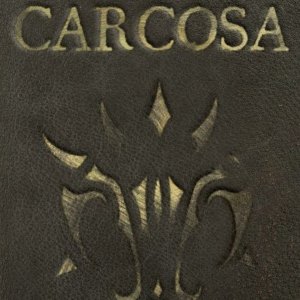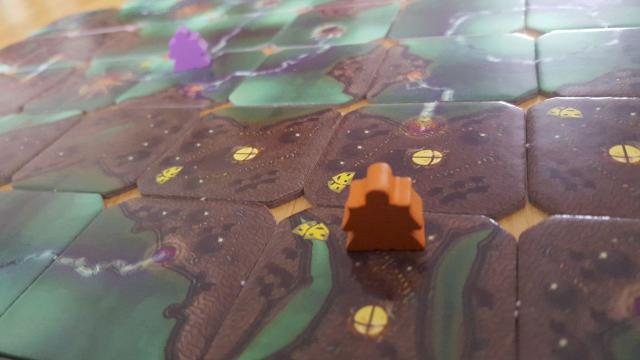
It’s incredibly easy to pass Carcosa off as just another Carcassonne clone. You lay tiles in such a way that the various features match up on the edges, placing meeples along the way to earn you points and drive you towards an end goal. But really, apart from the core mechanic of laying matching tiles there are relatively few differences, and some time with Carcosa shows some key differences that make it a worthy game in its own right.
One of the surprisingly big differences is how the tiles are drawn during the game. Instead of selecting an unseen tile and having to make it fit somewhere on the board, the tiles are placed into several piles whereby the top tile on each stack is visible. This takes away the fully random nature of tiles and brings some strategy into play – the scoring is much the same as Carcassonne, in so much as the meeples you place score points depending on how big the leylines, districts or whatever else end up being, so your tile selection will depend on a few different things, be that whether you want to grow an element you’re already working on, finish one off to bag some points or pick a tile that will screw over another player and stop them scoring any useful points themselves. You’ll also place one of your meeples on top of the pile you used, preventing the next player from using the next tile down on that stack. Despite being such a small tweak it makes a remarkable difference, and is enough by itself to give Carcosa its own identity.
But that’s not all this game has to offer. Your meeples (cultists in this case) aren’t always ready to rock and roll at a moment’s notice; when you complete a section of the board they go a bit insane and end up in your asylum, rendering them useless for the next couple of turns while they recover and then get themselves back to a ready state of mind. This can prevent you from flooding the board with your cultists later in the game, and adds an extra layer of thought over when to finish off your leylines and suchlike. Not only this, but when placing the tiles you’ll see they have two sides, representing an unstable or stable area of Carcosa. Initially they’re all unstable, meaning that instead of adding a tile to the board another player can remove an unstable tile and replace it with their own, causing all manner of potential mayhem for your planned outcomes. Once a feature is complete the tiles are turned to their stable side and things are a bit more set in stone, but as is becoming customary with these features it’s all part of the larger strategy picture.

There are quite a few other neat touches too that add to the whole cult-like theme of Carcosa, and it all comes together into a game that’s very good to play for two reasons. Firstly, the game isn’t overly complicated to play, and while there are some rule intricacies to pick up if you’ve played certain other tile placement games they’re easy to learn and adapt to. As such, much with likes of Carcassonne, this game is nice and easy to teach people who are willing to have their first game as a learning experience before playing properly. But the other thing I liked about this is how it goes to such lengths to not be Carcassonne. It would be very easy to piggyback on the success of that series and just make a clone with different tiles, but it’s more than that. The similarities are there, there’s no doubting that, but there’s enough of an original game here to be well worth having alongside other tile-placing games in your collection.
I suspect fans of Carcassonne might be put off by this with the assumption that it’s a dodgy copy – if that’s you, don’t be. Give it a go, and you’ll see how wrong your assumptions are.

Leave a Reply